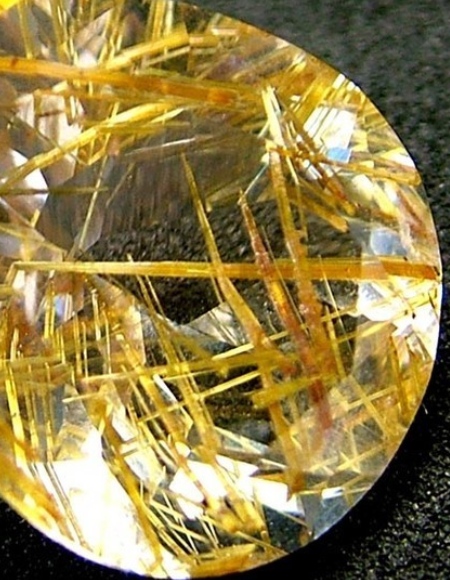
Rutile
As one of the most abundant minerals on Earth, it comes as no surprise that quartz is found in endless varieties. Rutilated quartz represents one of the more unusual types, as these stones are crystal clear examples of pure quartz, save for needle-like inclusions known as rutiles. Golden rutilated quartz features brilliant gold-colored rutile inclusions threaded in unique patterns throughout the stone.
What is a Rutile?
Rutile is a mineral in its own right, a form of natural titanium dioxide. They can range from a brownish, bloody red all the way through coppery or golden colors. Rutiles are responsible for the visual gem phenomenon asterism, otherwise known as the star effect that can be witnessed in gems such as star sapphire or black star diopside. Their metallic lustre is excellent for catching light and helps refract it throughout gemstones where they are present. Within the glassy finish of quartz, these inclusions provide additional captivating shimmer and shine as light plays across the unusual and unique patterns found in each stone.
What Determines a Rutile Pattern?
Rutile patterns are distinct and unique, and you will never witness the same pattern in two gems, even if they are from the same source! Golden rutiles are traditionally seen in quartz. The most prized patterns are six-rayed stars. However, though the commonly occur in quartz specimens, they are rare to find in gemstone examples. An expert eye is needed to shape the stone, orienting the rutile inclusion so that it best displays in its finished setting, all the while preserving the integrity of the stone.
Golden Rutilated Quartz Production
Minas Gerais is a Brazilian state responsible for the majority of gemstone production within the country, and for some kinds of gems, the world. Minas Gerais actually means “general mines” in Portuguese.
Many of the gemstones mined within the country form within pegmatites. These are formations of rock that are infused with crystallized minerals, or what we can consider the raw component of a faceted and polished gemstone.
Rough rutilated quartz is time-consuming to extract, as the quartz-bearing pegmatite’s form in treacherous, rocky terrain. The going is slow, as traditional hand tools like picks and shovels are required to remove the rough from the Earth.
Some gemstones carry a predictable yield as rough is cut and polished. Rutilated quartz, however, does not give this same guarantee. As discussed above, individual stones and a cutter’s patience and expertise dictate the formation of any particular gem. Rutile patterns, stone size, and the intended finished setting all influence how a gemstone will be shaped, faceted and polished. Adding to the rarity are the warm, brilliant golden rutiles. Gold rutiles are the most coveted on the market and usually fetch the highest price.
